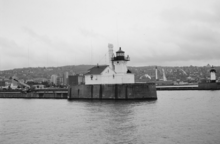Duluth South Breakwater Outer Light
 Duluth South Breakwater Outer Light (1985) | |
 | |
| Location | lake end of south pier of the Duluth Ship Canal |
|---|---|
| Coordinates | 46°46′48″N 92°05′15″W / 46.7801°N 92.0875°WCoordinates: 46°46′48″N 92°05′15″W / 46.7801°N 92.0875°W |
| Year first constructed | 1874 |
| Year first lit | 1901 |
| Foundation | Concrete pier |
| Construction | Brick |
| Tower shape | House with square tower |
| Markings / pattern | white with red roof |
| Focal height | 44 ft (13 m) |
| Original lens | Fourth order Fresnel lens |
| Range | 17 nm |
| Characteristic | Fixed Green |
| Fog signal | Horn |
| USCG number | [4] |
The Duluth South Breakwater Outer Light is a lighthouse at the end of the south breakwater of the Duluth Ship Canal. It forms a range with the Duluth South Breakwater Inner Light.
History
The appropriation which paid for the initial construction of this light was made in 1870, with the intent to build a structure at the end of the Northern Pacific Railroad docks.[4] Storm damage, however, delayed construction until 1872, by which point the canal had been dug.[4] A wooden pyramidal tower was erected, initially equipped with a fifth-order Fresnel lens.[3] An elevated walkway led back down the pier; a frame dwelling for the head keeper was constructed nearby, with the assistants required to look for lodging elsewhere in the city. This tower was first lit in 1874.[3][4]
The area is notoriously foggy, and an automated bell taken from the South Manitou Island Light, the first in a long series of fog signals, was installed in 1880.[4] This was replaced by a pair of steam-powered whistles in 1885, housed in a newly constructed shelter on the breakwater.[3] The noise from these whistles brought complaints from city residents, and a parabolic reflector mounted in a sawdust-filled box was installed in a successful effort to direct the sound out towards the lake.[3] Fog signal operation, it may be noted, averaged 472 hours a year for the first ten years of operation; in 1895 the whistles blew for 1,048 hours, an average of over four hours a day over the eight-month season.[3][4]
In 1886 the lens was upgraded to a fourth-order Fresnel lens, and the characteristic changed from a red and white flash to a fixed red signal.[4]
The late 1890s reconstruction of the ship canal resulted in the replacement of this tower and the fog signal house with a single brick lighthouse containing both signals.[4] This house, constructed of Cream City brick, was completed in 1901, and the new tower was first lit on September 1 of that year.[3] This tower stood on the southeast corner of the rectangular building, and housed the lens retained from the old light; the fog whistles and their reflector were also moved from the old structure to the new.[3][4] The latter were replaced in 1915 with locomotive whistles,[3] and in 1921 with Type F diaphones, setting off another round of noise complaints, which led to the installation of a new sound reflector. The diaphones were replaced in 1968 with an electronic horn,[3] but in 1976 a group styling itself TOOT (for "reTurn Our Old Tone") began a campaign to restore the fog signal.[4] Horns from the Kewaunee Pierhead Light were obtained,[3] and in 1995 the diaphones were put back in service, eliciting, of course, a new round of noise complaints, which led to restriction of the signal to daytime operation.[4] The signal required a three-phase current supply for operation, and when this failed in 2005, the Coast Guard refused to pay for repairs; legal concerns led the city to refuse to pick up the tab, and the signal was dismantled the following year.[4] The light, however, continues in service, displaying a fixed green light.[1]
The light was listed on the National Register of Historic Places in 2016.
References
- 1 2 Light List, Volume VII, Great Lakes (PDF). Light List. United States Coast Guard. 2012. p. 150.
- ↑ "Historic Light Station Information and Photography: Minnesota". United States Coast Guard Historian's Office.
- 1 2 3 4 5 6 7 8 9 10 11 Pepper, Terry. "Duluth South Breakwater Light". Archived from the original on 2012-07-13.
- 1 2 3 4 5 6 7 8 9 10 11 12 "Duluth Harbor South Breakwater Outer, MN". LighthouseFriends.
